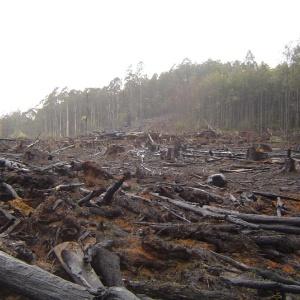
Taking as their starting point a hypothetical zero-deforestation for agricultural production, where people would refrain from clearing any further forests for agricultural purposes, the researchers behind this study look at both supply side and demand side measures to assess how changes in production and diet can assist in halting deforestation
The researchers explore the individual role of supply-side measures (including cropland output intensification and cropland expansion), efficiency measures in the livestock system (increases in feed-conversion ratios) and demand-side measures (quantitative and qualitative changes in the human diet). For each of these parameters, they collect published forecasts for 2050 and incorporate them into a consistent biomass balance model to assess their combined effects.
 The paper assesses the feasibility of a total of 500 scenarios. ‘Feasibility’ is defined as a situation in which global food demand is matched by cropland supply, and livestock grazing intensity stays within ecological thresholds. As shown in the image the dark boxes indicate the two inner quartiles (>25% <75%) of what are deemed feasible scenarios and the light-shaded boxes indicate the minimum and maximum values. The grazing intensity is measured as grazing harvest in per cent of actual NPP (net primary production). It is highly variable in the option space and in this image it is shown to strongly dependend on diets, with an intensity ranging from 0 to 36% of actual NPP.
The paper assesses the feasibility of a total of 500 scenarios. ‘Feasibility’ is defined as a situation in which global food demand is matched by cropland supply, and livestock grazing intensity stays within ecological thresholds. As shown in the image the dark boxes indicate the two inner quartiles (>25% <75%) of what are deemed feasible scenarios and the light-shaded boxes indicate the minimum and maximum values. The grazing intensity is measured as grazing harvest in per cent of actual NPP (net primary production). It is highly variable in the option space and in this image it is shown to strongly dependend on diets, with an intensity ranging from 0 to 36% of actual NPP.
Trade is assumed to balance deficits of regional production and consumption for all feasible scenarios, assuming no trade barriers exist. Although the paper does not support straightforward conclusions regarding the desirability, political practicability or sustainability performance of different scenarios, the authors describe what the option space is for the future (for 2050), defined as the sum of all feasible scenarios.
Although they conclude that more than 40% of all scenarios (211) are not feasible, the authors find that there are still many options to meet the global food demand without causing further deforestation. Human diets are found to be the strongest determinant of the biophysical option space, stronger than yields or cropland availability. Vegetarian or vegan diets are less often restricted by cropland availability or limits on the biomass supply of grazing land and show the largest number of feasible scenarios, in line with other studies. While noting that livestock provides many services other than food, they conclude that vegan or vegetarian diets are associated with only half the cropland demand, grazing intensity and overall biomass harvest of comparable meat-based human diets. High yields or intensive livestock systems scenarios have a smaller effect on the number of feasible scenarios than human diets on the overall option space, and if dietary choices are heavy on livestock products the land sparing from these scenarios can be annhilated. But low yield levels limit the number of feasible scenarios, particularly for diets with meat, which are affected primarily by cropland constraints. The results thus suggest that even in a zero-deforestation world, lower-yielding agriculture such as organic farming is a feasible option if paired with a vegetarian or vegan diet, or, to a lesser extent, if based on a massive cropland expansion. Further conclusions are that the expansion of cropland is not seen to critically influence the option space but that reducing waste levels could be another feasible deforestation reduction option that could make a substantial contribution to widen the option space.
The authors finally highlight a difficult balancing act between various policy priorities, in particular important for food security in developing countries. Their results show that there may be difficult trade-offs of certain scenarios with effects on self-sufficiency and import dependency. Given the finding that grazing pressure may become a prohibitive factor in many scenarios, they make a call for concerted research in this area.
Abstract
Safeguarding the world’s remaining forests is a high-priority goal. We assess the biophysical option space for feeding the world in 2050 in a hypothetical zero-deforestation world. We systematically combine realistic assumptions on future yields, agricultural areas, livestock feed and human diets. For each scenario, we determine whether the supply of crop products meets the demand and whether the grazing intensity stays within plausible limits. We find that many options exist to meet the global food supply in 2050 without deforestation, even at low crop-yield levels. Within the option space, individual scenarios differ greatly in terms of biomass harvest, cropland demand and grazing intensity, depending primarily on the quantitative and qualitative aspects of human diets. Grazing constraints strongly limit the option space. Without the option to encroach into natural or semi-natural land, trade volumes will rise in scenarios with globally converging diets, thereby decreasing the food self-sufficiency of many developing regions.
Citation
Erb, K-H., Lauk, C., Kastner, T., Mayer, A., Theurl, M. C., Haberl, H., (2016).
Exploring the biophysical option space for feeding the world without deforestation, Nature Communications 7, doi:10.1038/ncomms11382
Read the full paper in Nature communications here.
Read more about sustainable intensification, livestock systems, crop systems, land use and land use change in our research library.







Post a new comment »